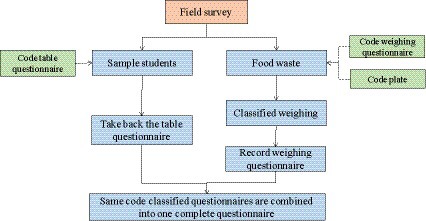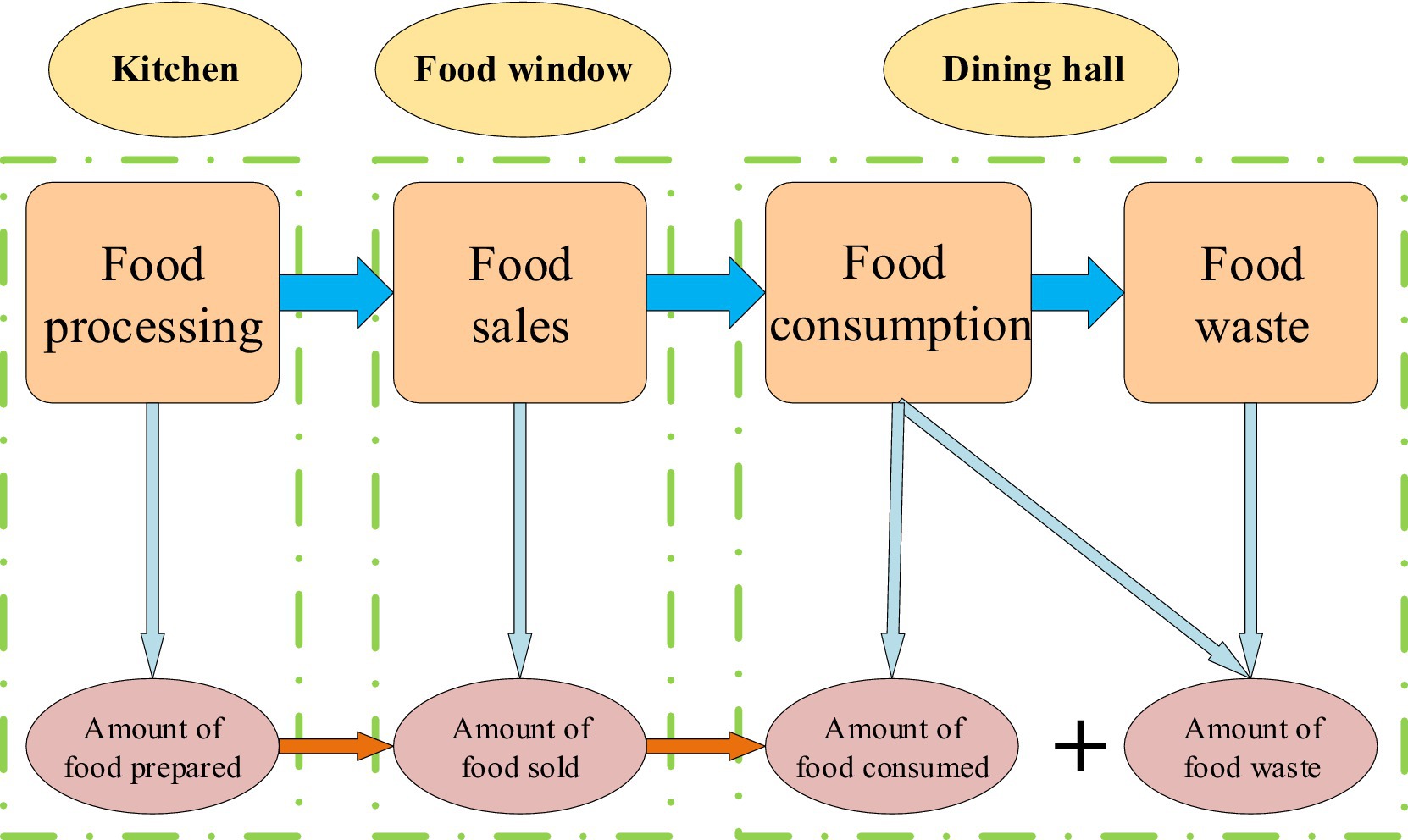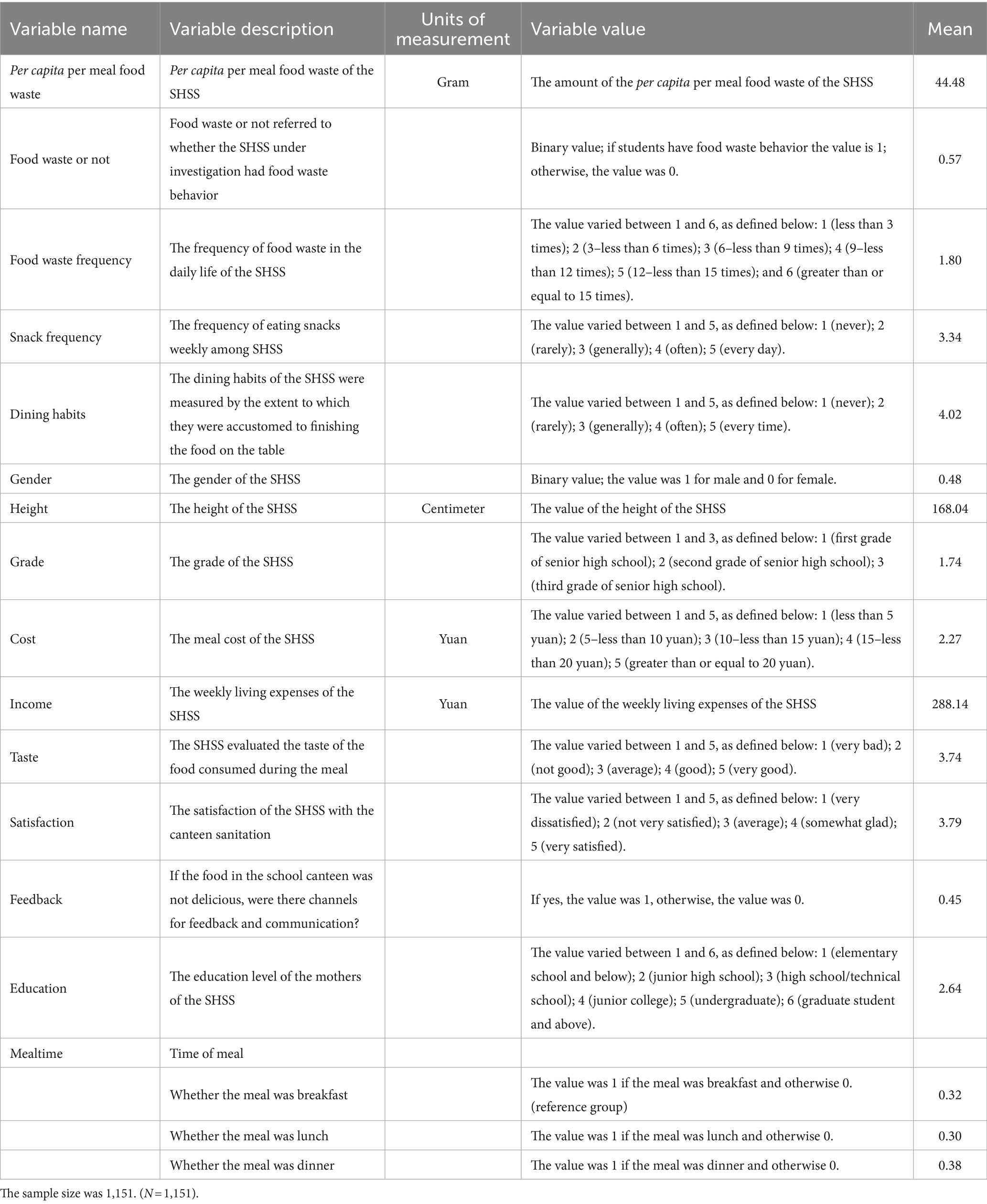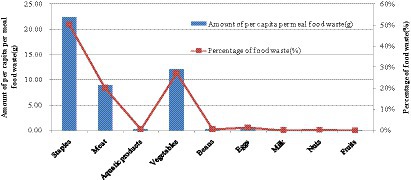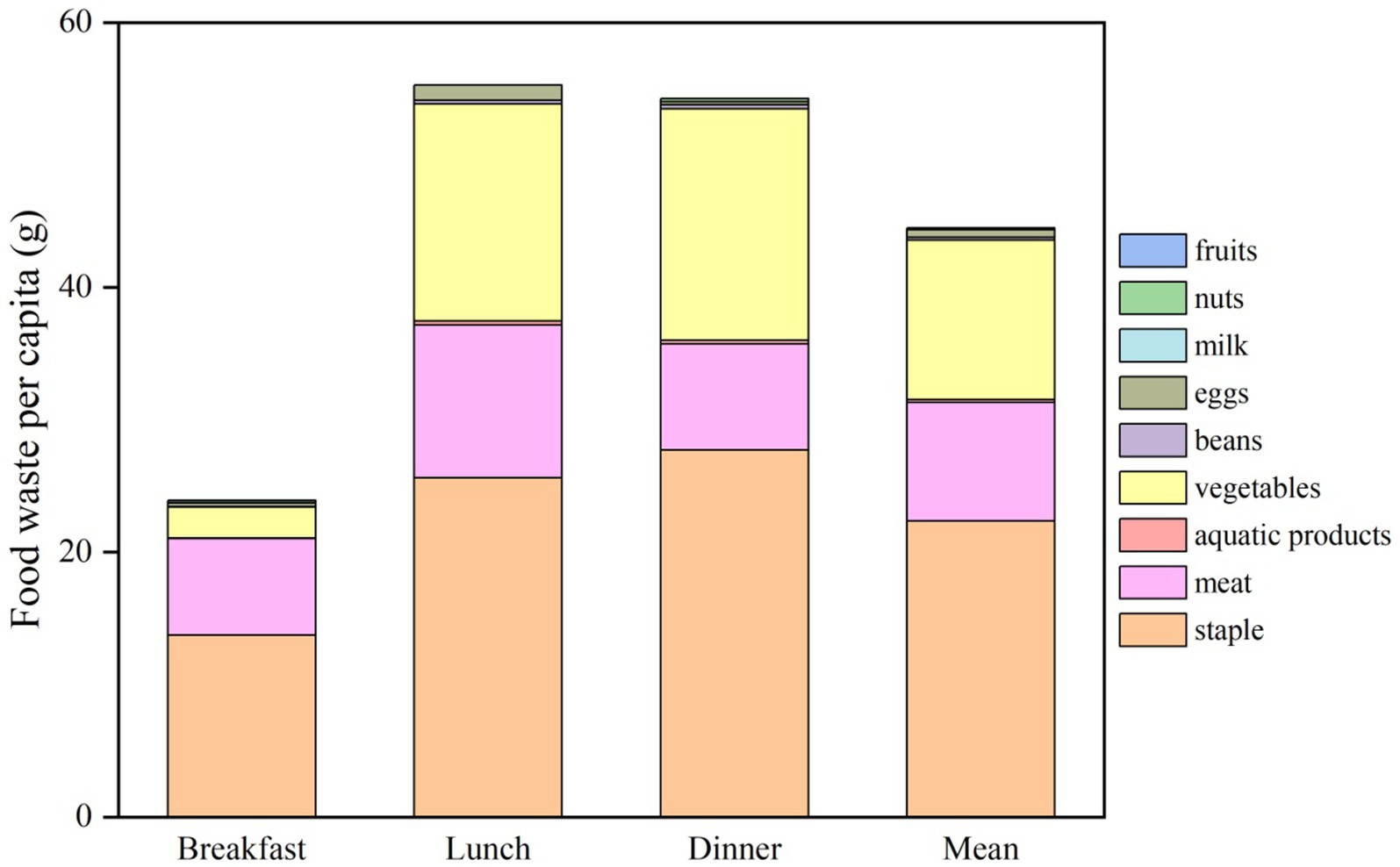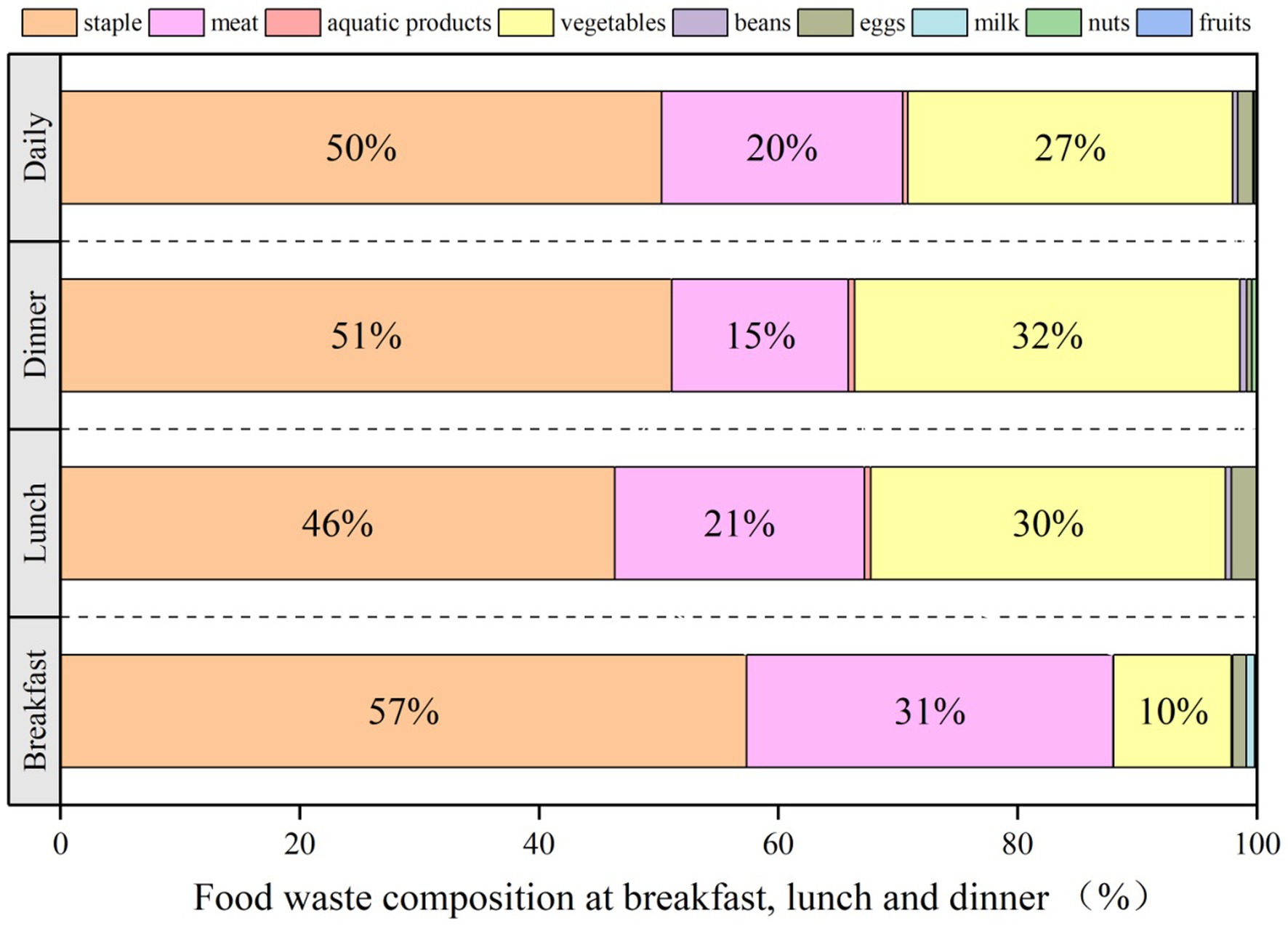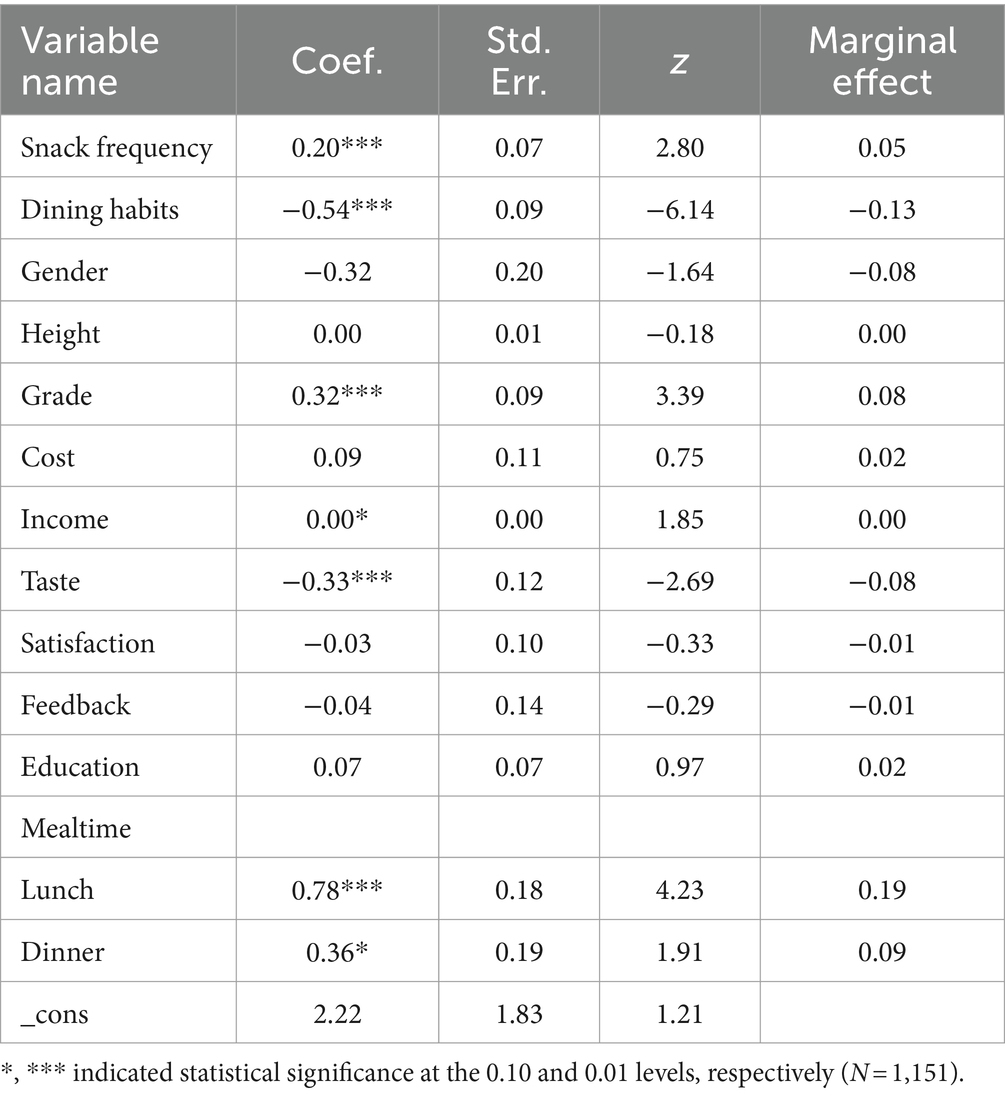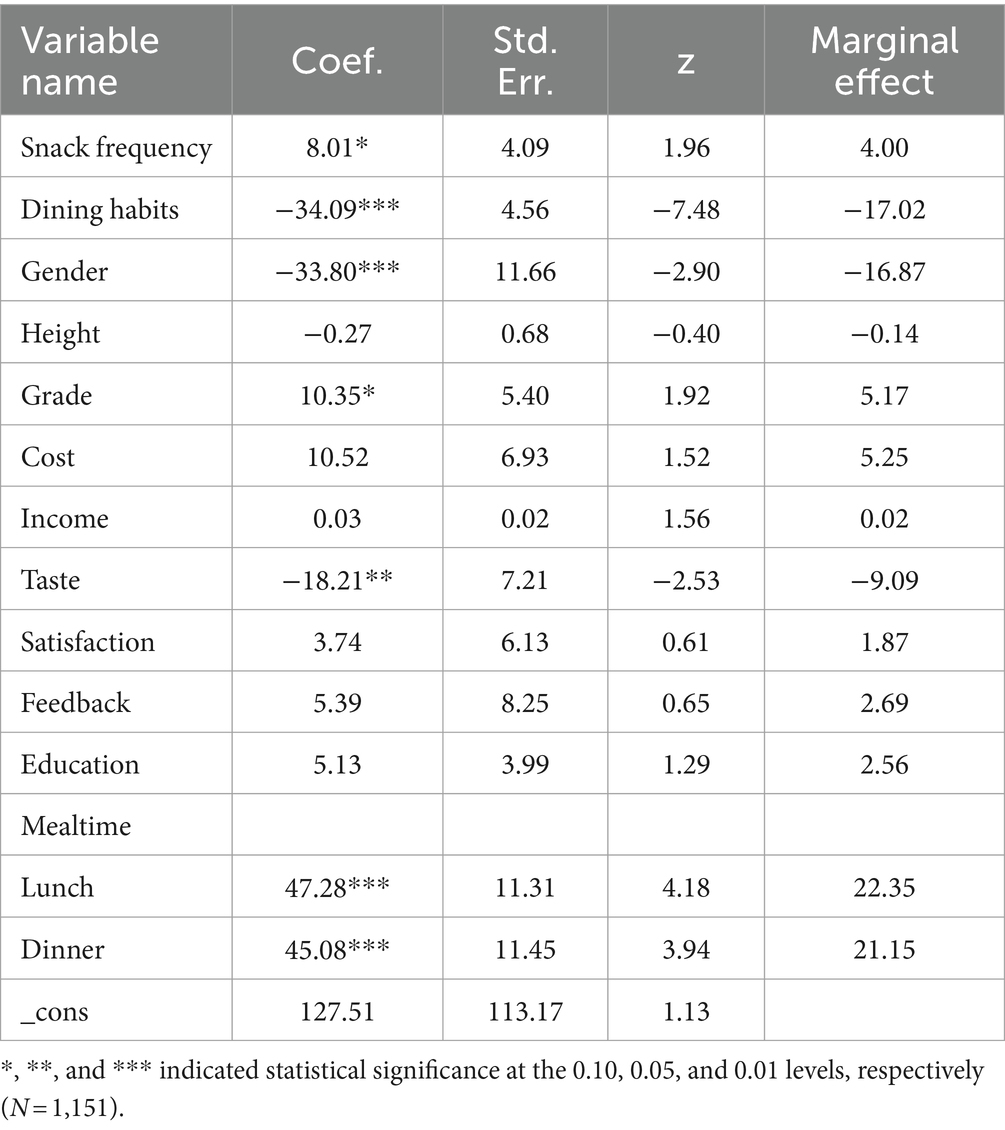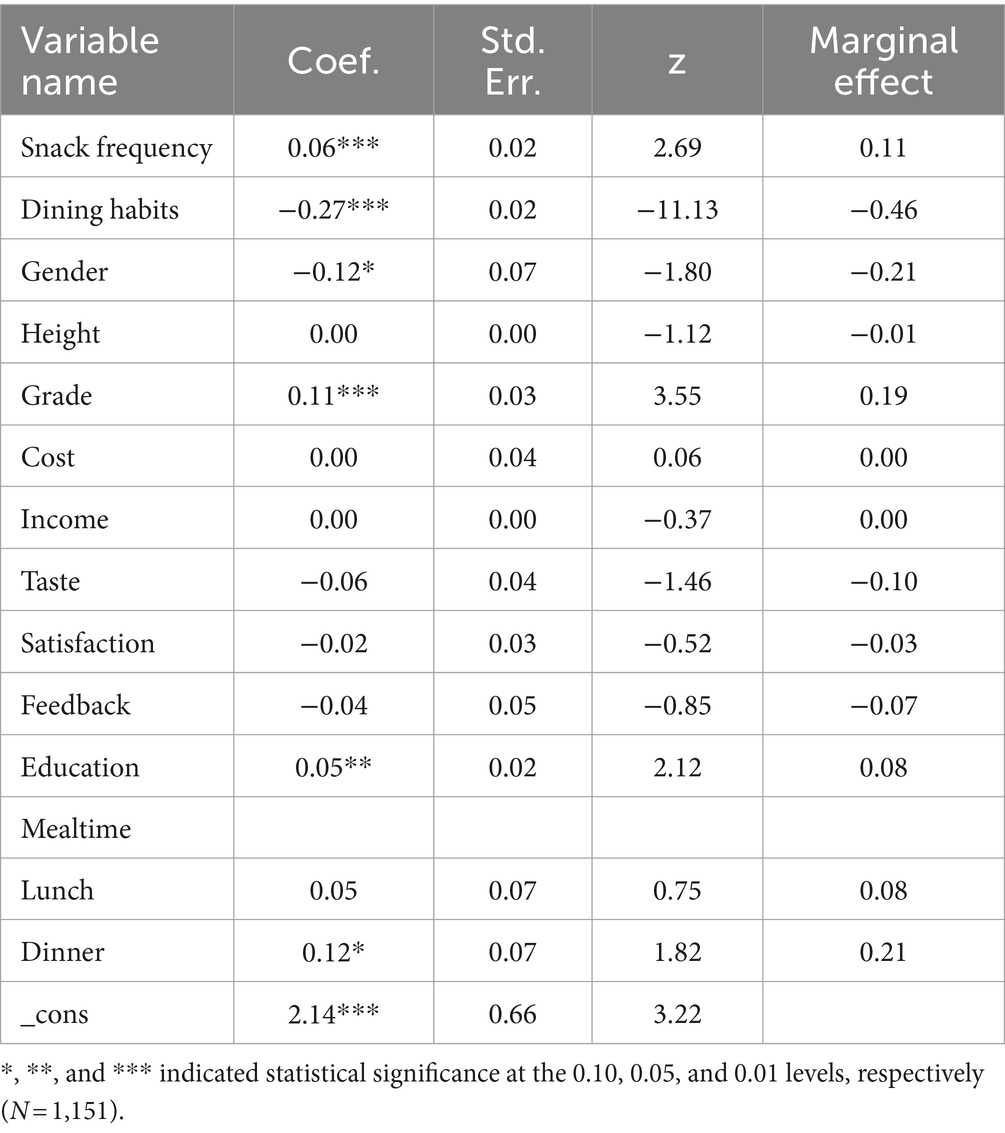- 1School of Economics and Trade, Henan University of Technology, Zhengzhou, Henan, China
- 2Institute of Geographic Sciences and Natural Resources Research, Chinese Academy of Sciences (CAS), Beijing, China
Food waste is increasingly becoming a global challenge, and school canteens are a significant and severe source of food waste. Reducing food waste is conducive to ensuring food security and environmental sustainability. A good understanding on the influencing factors of food waste is a prerequisite for exploring effective measures to reduce food waste. We obtained senior high school first-hand food waste data through field survey using the methods of face-to-face interview, questionnaire survey, and direct weighing in September 2019. Our survey data showed that the per capita per meal food waste of senior high school students (SHSS) was 44.48 g. The specific performance was as follows: the per capita per meal food waste of breakfast, lunch, and dinner was 22.39, 55.28, and 54.24 g, respectively. The empirical results showed that the frequency of eating snacks had a significant effect on whether the SHSS had food waste behavior and significantly affected the amount of food waste by SHSS. With the increased frequency of eating snacks, the food waste probability was increased and the amount of food waste was greater. This study suggested that we could eat snacks but reduced the frequency of eating snacks to achieve the goal of mitigating food waste. This was a simple and effective way to reduce food waste.
1 Introduction
Food waste was a global challenge, which had attracted widespread attention in recent years (Thyberg et al., 2015; Young et al., 2017; Bretter et al., 2022). Global food waste undermined the resilience and sustainability of food systems (Guo et al., 2023). Reducing food waste could be extremely beneficial to food security and environmental sustainability (Foley et al., 2011). In 2019, nearly 750 million people were exposed to severe levels of food insecurity, accounting for almost one-tenth of the world’s total population (FAO, IFAD, UNICEF, WFP, WHO, 2020). However, roughly one-third of food produced for human consumption was lost or wasted globally, which amounts to approximately 1.3 billion tons per year (Gustavsson et al., 2011). Food waste meant not only a large amount of food was thrown away but also the ineffective consumption of large amount of water, energy, and land required for food production (Cheng et al., 2012). Food waste negatively contributed to global greenhouse gas emission (Clark et al., 2020; Rosenzweig et al., 2020) and caused serious pressure on resources and environment (Kummu et al., 2012; Xue et al., 2021). Therefore, food waste should be studied.
Scholars had studied food waste in different departments, such as households (Schmidt, 2016; Aschemann-witzel et al., 2019; Cao and Li, 2023), restaurants (Zhang et al., 2018; Filimonau et al., 2022; Zhang and Zhang, 2022), catering industry (Filimonau and Ermolaev, 2021; Gao et al., 2021; Zhang et al., 2022), and schools (Blondin et al., 2014; Falasconi et al., 2015; Schwartz et al., 2015). Most existing studies of food loss and waste were conducted for a few industrialized countries, such as the United Kingdom and the United States (Xue et al., 2017). In recent years, scholars conducted some research studies on food waste at school canteens in different countries, such as the United States (Whitehair et al., 2013), South Africa (Painter et al., 2016), Germany (Lorenz et al., 2017), and Portugal (Pinto et al., 2018).
Food waste at school canteens needed more attention (Principato et al., 2015; Derqui et al., 2018). Schools were an important source of food waste (Derqui and Fernandez, 2017; Qian and Xiong, 2022). The per capita per meal food waste for university students was 73.7 g (Wu et al., 2019). Food waste on plates accounted for 22% of the total food preparation in school canteens (Boschini et al., 2018). The per capita per meal food waste of college students at school canteens in China was 61.03 g, and up to 74% of the students had food waste behavior (Qian et al., 2019). In terms of research on school food waste, the current publications on school food waste were mainly concentrated in nursery schools (Steen et al., 2018; García-Herrero et al., 2019), primary schools (Byker et al., 2014; Martins et al., 2020), middle schools (Smith and Cunningham-sabo, 2013; Liu et al., 2016), and universities (Wu et al., 2019; Qian et al., 2024), and a small part of the research study was conducted on senior high schools.
Most of the situational research studies about snacks had been conducted in the context of the snacks market (Gehrt and Shim, 2003), snacks choices (Raska and Nichols, 2012), and consumption of snacks (Benton and Jarvis, 2007; Ansem et al., 2015). Learning collaborative could facilitate improvements in the quality of after-school snacks (Mozaffarian et al., 2010). Both parents and peers influenced children’s consumption of snacks (Ansem et al., 2015). Older and younger adults with weaker executive function consumed more high-calorie snacks (Hall et al., 2015). A study used questionnaire approach to measure the relative reinforcing efficacy of snacks (Epstein et al., 2010). Research was conducted on the relationship between obesity and snacks (Havermans et al., 2011). Eating non-nutrient snacks was considered a major factor leading to childhood obesity (Wansink et al., 2013). Strategies should be implemented to reduce the intake of fat and sugar by adolescents while consuming snacks (Howard and Reeves, 2005). To date, there was no literature had examined the effect of the frequency of eating snacks on food waste.
Senior high school is a critical period for the formation of an outlook on life and values, which is related to the future of the country. Senior high school students (SHSS) are an integral part of society. Public school canteens represented a unique environment with the ability to convey eating habits and knowledge (García-Herrero et al., 2019). In recent years, scholars have conducted research on measures to reduce food waste (Goossens et al., 2019). Study on the influencing factors of food waste was a necessary step in reducing food waste, and identification of key influencing factors was essential to exploring effective and practical measures to reduce food waste. Does the frequency of eating snacks increase food waste? If so, we could reduce the frequency of eating snacks to reduce food waste, which would be a simple and feasible method to reduce food waste.
In this study, food waste was calculated based on a field survey. Based on first-hand data through direct weighing on food waste, we empirically analyzed the impact of the frequency of eating snacks on food waste behavior among SHSS. In the field survey, we separately evaluated the amount of food waste for breakfast, lunch, and dinner, which more accurately measured the amount of food waste in SHSS.
2 Materials and methods
2.1 Field survey
The food waste survey was conducted on September 2019. A total of 1,210 survey samples were collected during the survey process. Through data cleaning and scientific screening, samples with low questionnaire validity were eliminated, and 1,151 valid samples were obtained, with a questionnaire validity rate of 95.12%.
The site of the field survey was Senior High School, Changshu City, Jiangsu Province, China. This study adopted the methods of face-to-face interview, questionnaire survey, and direct weighing. The face-to-face interview focused on the canteen operators and chefs to find out the number of SHSS dining at each meal, and the quality and quantity of dishes served in the canteens. The questionnaire survey was aimed at SHSS who eat in the canteens to learn about their individual characteristics, parents’ educational level, consumption philosophy, dining habits, etc. The direct weighing was aimed at weighing the amount of food waste at the dining table of SHSS by directly weighing the edible discarded portion of the food remaining on the table, excluding liquids. We used a kitchen baking electronic scale for direct weighing, which was accurate to 1 g.
In the field survey process, combined with the total number of the SHSS and the sample size set by the study group, random sampling and systematic sampling were used to obtain samples. The canteens in Shanghu Senior High School had three floors, and there was no plate collection office in the canteens, which adopted the method of staff carts moving between the dining tables. According to the characteristics of the canteens, the research team was divided into three groups and conducted an investigation on each floor of the canteens at the same time.
In the field survey, the specific method of sampling samples was as follows: combined with the face-to-face interview content of the canteens, the research divided the number of dining students into several periods according to the scale of the canteens and student flow. A sample was drawn from each eating period to reach the expected number of samples for the field survey. To ensure that students hide their food waste behavior, we conducted the questionnaire survey after the students finished their meals. The field survey operation flow chart is shown in Figure 1.
2.2 System definition
In this study, food waste was defined as the edible, non-liquid, discarded portion of the food left on the dining tables by the SHSS during the meal process, excluding the inedible ingredients and bones. The concept map of food waste formation in this study is shown in Figure 2. When assessing the amount of food waste, we converted the amount of food waste into the weight of raw food materials. Therefore, the amount of food waste referred to the weight of raw food materials of edible ingredients left on the dining tables.
If there was a phenomenon of packing during meals of the SHSS, the amount of food packed was not included in the category of food waste due to the assumption that the SHSS packed food for re-consumption. In this study, food was divided into nine categories, including staples, meat, aquatic products, vegetables, beans, eggs, milk, nuts, and fruits.
2.3 Description of variables
There were three explained variables in this study, namely, per capita per meal food waste, food waste or not, and food waste frequency. The per capita per meal food waste referred to the weight of per capita per meal food waste for the SHSS, which was calculated based on the weighing data. The food waste or not referred to whether the SHSS under investigation had food waste behavior, a binary variable with a value of 1 if the SHSS had food waste behavior and 0 if the SHSS did not have food waste behavior. The food waste frequency referred to the frequency of food waste in the daily life of the SHSS.
This study proposed some influential factors that led to food waste, including dining habits, gender, and grade. The definitions and descriptions of the main variables in this study are shown in Table 1.
2.4 Food waste calculation
The calculation method of food waste is shown in the following formulas:
Total amount of food waste:
In the formula above, represented the total amount of food waste, represented the waste amount of the i-th type food of the j-th sample student, represented the number of categories of food, and represented the number of students in the sample.
The proportion of classified food waste to total food waste is as follows:
In the formula above, represented the proportion of the i-th food waste to the total waste, represented the number of students in the sample, represented the total amount of food waste, and represented the waste amount of the i-th type food of the j-th sample student.
Per capita per meal food waste is as follows:
In the formula above, represented the total amount of per capita per meal food waste, represented the waste amount of the i-th type food of the j-th sample student, represented the number of categories of food, and represented the number of students in the sample.
Per capita per meal food waste at breakfast, lunch, and dinner is as follows:
In the formula above, represented the per capita per meal food waste of each meal (k ranged from 1 to 3, k = 1 represented breakfast, k = 2 represented lunch, and k = 3 represented dinner).
3 Results
3.1 Overview
A total of 1,151 samples were included in this study, of which 555 were men, accounting for 48.22%, and 596 were women, accounting for 51.78%. The sample sizes for the breakfast, lunch, and dinner period were 364, 344, and 443, respectively. The percentage of breakfast, lunch, and dinner time in the sample was 31.62, 29.89, and 38.49%, respectively. In the total sample, 497 samples had zero food waste, and 654 samples had greater than zero food waste.
3.2 Food waste by type
The per capita per meal food waste of the SHSS was 44.48 g, of which the per capita per meal of fruit waste was close to zero, and the per capita per meal of dried fruits/nuts and milk waste was 0.09 and 0.06 g, respectively. The foods that were wasted more by the SHSS mainly included staples and vegetables, which was consistent with the existing food waste research conclusions (Wang et al., 2017; Kasavan et al., 2021).
The per capita per meal staple waste of the SHSS was 22.35 g, accounting for 50.24% of the per capita per meal food waste. The per capita per meal vegetable waste of the SHSS was 12.07 g, accounting for 27.14% of the per capita per meal food waste. The per capita per meal meat waste of the SHSS was 8.96 g, accounting for 20.15% of the per capita per meal food waste. The per capita per meal food waste by the type in this study is shown in Figure 3.
3.3 Food waste at breakfast, lunch, and dinner
There were differences in the amount of per capita per meal food waste among the SHSS for breakfast, lunch, and dinner. The amount of per capita per meal food waste for breakfast was less than that for lunch and dinner. Specifically, the per capita per meal food waste was 23.91 g for breakfast, 55.28 g for lunch, and 54.24 g for dinner. During the breakfast period, the food waste of the SHSS was mainly staples and meat. During the lunch period, the food waste of the SHSS was mainly staples and vegetables, of which the milk, nuts, and fruits were not wasted. During the dinner period, the food waste of the SHSS was mainly staples and vegetables, and there was no waste of milk and fruits. The amount of food waste per capita at breakfast, lunch, and dinner is shown in Figure 4. The percentage of food waste per capita at breakfast, lunch, and dinner is shown in Figure 5.
3.4 Relationship between snack frequency and food waste
We used the Logit model to analyze whether the frequency of eating snacks affected food waste behavior and the Tobit model to analyze whether the frequency of eating snacks affected the amount of food waste. The estimation results of Logit model and Tobit model are shown in Tables 2, 3, respectively.
The results showed that snack frequency among the SHSS had a significant effect on whether the SHSS had food waste behavior and also significantly affected the amount of food waste by SHSS. The survey data showed that the per capita per meal food waste with the everyday frequency of eating snacks was 63.71 g, which was higher than the average level. In other words, the snack frequency increased the food waste probability of the SHSS, and with the increase in the frequency of eating snacks, the amount of food waste would also increase. The empirical analysis results showed that compared with SHSS who did not eat snacks, those who had the habit of eating snacks were more likely to have food waste behavior. The empirical analysis also showed that the SHSS who eat snacks more frequently were more prone to food waste behavior, and with the increased frequency of eating snacks, the per capita per meal food waste was greater.
To test the robustness of the results, food waste frequency was used to estimate the counting model instead of the per capita per meal food waste of the SHSS during their school meals. The robustness test estimation results are shown in Table 4. The robustness test estimation results showed that the frequency of eating snacks significantly affected the food waste behavior, and with the improvement in the frequency of eating snacks, the food waste frequency of the SHSS increased. Therefore, the original conclusion was robust.
3.5 Other influencing factors of food waste
The other influencing factors of food waste for SHSS were analyzed as follows:
3.5.1 Dining habits
The SHSS with different eating habits had various food waste behaviors. The survey data showed that per capita per meal food waste of the SHSS with the best eating habits was 23.82 g, and that with the worst eating habits was 200.52 g. The empirical results showed that dining habits significantly affected whether the SHSS had food waste behavior, mainly reflected in the fact that the SHSS with better dining habits had less food waste behavior. The empirical results also showed that dining habits significantly affected the amount of per capita per meal food waste produced by the SHSS, which was mainly reflected in the fact that the SHSS with better eating habits would waste small amount of food. Overall, the SHSS with better eating habits tended to no food waste or waste small amount of food, and those with poorer eating habits tended to waste more amount of food.
3.5.2 Gender
The gender of the SHSS had a significant effect on the amount of food waste, but there was no significant effect on whether they had food waste behavior. The survey data showed that the per capita per meal food waste of the senior high school boys was 30.03 g, and the per capita per meal food waste of the senior high school girls was 57.94 g. The analysis of the empirical results showed that there was no difference in the influence of gender on food waste behavior. There were significant differences in the amount of food waste among the SHSS of different genders; specifically, the amount of food waste of senior high school boys was significantly lower than that of senior high school girls.
3.5.3 Grade
The SHSS of different grades had various food waste behaviors. The survey data showed that the per capita per meal food waste of the first grade of SHSS was 37.52 g, the per capita per meal food waste of the second grade of SHSS was 43.15 g, and the per capita per meal food waste of the third grade of SHSS was 62.60 g. The empirical results showed that the higher the grade level, the more likely the SHSS were to have food waste behavior. The empirical results also showed that the grade significantly affected the amount of food wasted of the SHSS during meals: the higher the grade of the SHSS, the greater the amount of food waste; the lower the grade of the SHSS, the smaller the amount of food waste. In general, the higher the grade of the SHSS, the more likely they were to have food waste behavior and the greater amount of food waste.
3.5.4 Taste
The taste had a significant effect on whether the SHSS had food waste behavior. With the improvement in food taste satisfaction, the SHSS were less inclined to food waste behavior. Food taste perception significantly influenced the amount of food waste among the SHSS, and the SHSS with a better perception of food consumed had smaller amount of food waste.
3.5.5 Mealtime
The SHSS during different mealtime had different food waste behaviors. The survey data showed that the per capita per meal food waste of the SHSS was 22.39 g at breakfast, 55.28 g at lunch, and 54.24 g at dinner. The empirical results showed that mealtime significantly affected whether the SHSS had food waste behavior. Eating at lunch time and dinner time significantly increased the likelihood of food waste compared with breakfast time. The empirical results also showed that mealtime significantly affected the amount of food waste by SHSS, and the amount of food waste at lunch time and dinner time increased significantly compared with the amount of food wasted at breakfast time.
4 Discussion
In recent years, scholars had conducted research and made contributions to the issue of food waste (Mena et al., 2011; Bravi et al., 2020), paving the way for the follow-up study of food waste. In recent years, anti-food waste initiated the agenda, and constructing a long-term mechanism to anti-food waste became an important research proposal. How to simply and effectively reduce food waste was of great significance for conducting research on food waste. For example, research had shown that plate and decoration color affected consumer food waste behavior (Zhang et al., 2022), and changing plate and decoration color to reduce food waste was a simple and feasible way.
This study believed that effective measures to reduce food waste should be sought from the factors that impact food waste behavior, and these factors could be modifiable. For example, the results of this study showed that the frequency of eating snacks had an essential impact on food waste behavior of the SHSS, which indicated that anti-food waste could start from reducing the frequency of eating snacks. Reducing the frequency of eating snacks might be improved through comprehensive and systematic diet-related education. In other words, we should take measures to improve the factors that significantly impact food waste behavior, providing that these factors can be modifiable to achieve the goal of reducing food waste.
The contributions of this study were the following two aspects. First of all, to comprehensively reflecting the food waste behavior of SHSS in school canteens, we investigated the food waste situation of breakfast, lunch, and dinner. Regarding the time category of school food waste research, existing research mainly focused on lunch time and dinner time (Smith and Cunningham-sabo, 2013; Boschini et al., 2018; Ellison et al., 2019; Martins et al., 2020) but ignored the research on food waste of breakfast in schools, which was not conducive to systematically characterizing the overall situation of food waste in schools. Second, we used direct weighing to obtain SHSS first-hand data on food waste by the field survey. More than half of the literature on food waste used secondary data for research on food waste (Halloran et al., 2014; Xue et al., 2017). We believed that using first-hand data to measure food waste was more accurate.
In general, reducing food waste was a process of changing bad habits and gradually establishing new patterns of civilization. Experts in the field actively advocated and promoted food education (Liu et al., 2020). In the past few years, China’s food consumption patterns have undergone significant changes (Dong et al., 2015). Especially, fast food consumption caused health problems for residents, such as obesity (Hou et al., 2018). For health reasons, we should reduce fast food consumption. Food education was conducive to cultivating and educating good dining habits (Zhu et al., 2020), which helped to reduce food waste (Hou et al., 2018). Schools are an important place to promote food education. Schools should reduce the provision of fast food and promote healthy eating habits. Carrying out school-based food education actions is an important foundation for inheriting the excellent food culture of the Chinese nation and achieving the goals of children’s physical and mental health. It is vital and necessary to carry out food education for students in different school stages.
5 Conclusion and limitation
5.1 Conclusion
Data showed that 56.82% of the SHSS had food waste behavior. Based on the first-hand data on food waste field survey of senior high school, this study used the Logit model to estimate whether the SHSS had food waste behavior and the Tobit model to estimate the effect on influencing factors of food waste behavior. The results showed that the per capita per meal food waste of the SHSS was 44.48 g, of which staples, vegetables, and meat staples, vegetables, and meat were 22.35, 12.07, and 8.96 g, respectively.
There were differences in the amount of per capita per meal food waste at breakfast, lunch, and dinner. The per capita per meal food waste of breakfast, lunch, and dinner was 22.39, 55.28, and 54.24 g, respectively. The per capita per meal food waste at breakfast mainly included staples, vegetables, and meat, which were 12.73, 7.67, and 1.42 g, respectively. The per capita per meal food waste at lunch mainly included staples, vegetables, and meat, which were 25.61, 16.38, and 11.55 g, respectively. The per capita per meal food waste at dinner mainly included staples, vegetables, and meat, which were 27.71, 17.47, and 8.02 g, respectively.
The food waste behavior was affected by dining habits, gender, taste, mealtime, and frequency of eating snacks. The results provided a method to reduce food waste, so it had theoretical and practical implications. Specifically, we could reduce food waste by reducing the frequency of eating snacks. This study suggested that we could eat snacks but reduced the frequency of eating snacks to achieve the goal of reducing food waste. This was a simple and effective way to reduce food waste.
5.2 Limitation
There are still some limitations in this study, mainly including two aspects. First, the data had limitations. The data in this study came from the first-hand data of a city field survey, and the coverage was small. If more samples from more provinces could be used as supplementary data in the future, it would provide more reliable data support for related study. Second, in addition to the influencing factors shown in this study, the food waste behavior of SHSS might be affected by other factors, for example, the psychological state of SHSS when dining. In future study, we would increase the investigation and analysis of these factors.
The dining patterns of senior high school students in different countries were different, so the factors affecting their food waste might be different, which required food waste data of more countries to get the global food waste situation of school canteens. When analyzing the situation of food waste at schools in different countries, it should be combined with local characteristics, for example, dietary cultural factors. We suggested that scholars from different countries should consider cooperative research on food waste at schools.
Data availability statement
The raw data supporting the conclusions of this article will be made available by the authors, without undue reservation.
Author contributions
PZ: Conceptualization, Data curation, Funding acquisition, Investigation, Methodology, Writing – original draft, Writing – review & editing. WZ: Data curation, Methodology, Writing – review & editing. XL: Conceptualization, Data curation, Funding acquisition, Investigation, Writing – original draft, Writing – review & editing. FS: Methodology, Writing – review & editing.
Funding
The author(s) declare that financial support was received for the research, authorship, and/or publication of this article. This study was supported by Annual Project of Philosophy and Social Sciences in Henan Province (2022CJJ136), Project of Federation of Social Sciences in Henan Province (SKL-2023-2719), Basic Research Leading Talents Project of Central Plains Thousand Talents (ZYQR201810122), and National Natural Science Foundation of China (71874178).
Conflict of interest
The authors declare that the research was conducted in the absence of any commercial or financial relationships that could be construed as a potential conflict of interest.
Publisher’s note
All claims expressed in this article are solely those of the authors and do not necessarily represent those of their affiliated organizations, or those of the publisher, the editors and the reviewers. Any product that may be evaluated in this article, or claim that may be made by its manufacturer, is not guaranteed or endorsed by the publisher.
References
Ansem, W. J. C. V., Schrijvers, C. T. M., Rodenburg, R., and Mheen, D. V. D. (2015). Children’s snack consumption: role of parents, peers and child snack-purchasing behaviour. Results from the INPACT study. Eur. J. Pub. Health 25, 1006–1011. doi: 10.1093/eurpub/ckv098
Aschemann-Witzel, J., Giménez, A., and Ares, G. (2019). Household food waste in an emerging country and the reasons why: Consumer’s own accounts and how it differs for target groups. Resources Conserv. Recycl. 145, 332–338. doi: 10.1016/j.resconrec.2019.03.001
Benton, D., and Jarvis, M. (2007). The role of breakfast and a mid-morning snack on the ability of children to concentrate at school. Physiol. Behav. 90, 382–385. doi: 10.1016/j.physbeh.2006.09.029
Blondin, S. A., Djang, H. C., Metayer, N., Anzman-Frasca, S., and Economos, C. D. (2014). It's just so much waste.' a qualitative investigation of food waste in a universal free school breakfast program. Public Health Nutr. 18, 1565–1577. doi: 10.1017/S1368980014002948
Boschini, M., Falasconi, L., Giordano, C., and Alboni, F. (2018). Food waste in school canteens: a reference methodology for large-scale studies. J. Clean. Prod. 182, 1024–1032. doi: 10.1016/j.jclepro.2018.02.040
Bravi, L., Francioni, B., Murmura, F., and Savelli, E. (2020). Food waste in school catering: an Italian case study. Resourc. Conserv. Recycl. 153:104586. doi: 10.1016/j.resconrec.2019.104586
Bretter, C., Unsworth, K. L., Russell, S. V., Quested, T. E., Doriza, A., and Kaptan, G. (2022). Don’t put all your eggs in one basket: testing an integrative model of household food waste. Resourc. Conserv. Recycl. 185:106442. doi: 10.1016/j.resconrec.2022.106442
Byker, C. J., Farris, A. R., Marcenelle, M., Davis, G. C., and Serrano, E. L. (2014). Food waste in a school nutrition program after implementation of new lunch program guidelines. J. Nutr. Educ. Behav. 46, 406–411. doi: 10.1016/j.jneb.2014.03.009
Cao, X., and Li, X. (2023). Will healthy diets increase household food waste? Front. Sustain. Food Syst. 7:1180741. doi: 10.3389/fsufs.2023.1180741
Cheng, S. K., Gao, L. W., Xu, Z. R., Tang, C. C., Wang, L. E., and Dhruba, B. G. C. (2012). Food waste in catering industry and its impacts on resources and environment in China. China Soft Sci. 7, 106–114.
Clark, M. A., Domingo, N. G. G., Colgan, K., Thakrar, S. K., Tilman, D., Lynch, J., et al. (2020). Global food system emissions could preclude achieving the 1.5° and 2°C climate change targets. Science 370, 705–708. doi: 10.1126/science.aba7357
Derqui, B., and Fernandez, V. (2017). The opportunity of tracking food waste in school canteens: guidelines for self-assessment. Waste Manag. 69, 431–444. doi: 10.1016/j.wasman.2017.07.030
Derqui, B., Fernandez, V., and Fayos, T. (2018). Towards more sustainable food systems. Addressing food waste at school canteens. Appetite 129, 1–11. doi: 10.1016/j.appet.2018.06.022
Dong, W. L., Wang, X. B., and Yang, J. (2015). Future perspective of China’s feed demand and supply during its fast transition period of food consumption. J. Integr. Agric. 14, 1092–1100. doi: 10.1016/S2095-3119(14)60992-8
Ellison, B., Savchenko, O., Nikolaus, C. J., and Duff, B. R. L. (2019). Every plate counts: evaluation of a food waste reduction campaign in a university dining hall. Resour. Conserv. Recycl. 144, 276–284. doi: 10.1016/j.resconrec.2019.01.046
Epstein, L. H., Dearing, K. K., and Roba, L. G. (2010). A questionnaire approach to measuring the relative reinforcing efficacy of snack foods. Eat. Behav. 11, 67–73. doi: 10.1016/j.eatbeh.2009.09.006
Falasconi, L., Vittuari, M., Politano, A., and Segrè, A. (2015). Food waste in school catering: an Italian case study. Sustain. For. 7, 14745–14760. doi: 10.3390/su71114745
FAO, IFAD, UNICEF, WFP, WHO. (2020). The state of food security and nutrition in the world 2020. Transforming food systems for affordable healthy diets. FAO: Rome, Italy.
Filimonau, V., and Ermolaev, V. A. (2021). A sleeping giant? Food waste in the foodservice sector of Russia. J. Clean. Prod. 297:126705. doi: 10.1016/j.jclepro.2021.126705
Filimonau, V., Matyakubov, U., Allonazarov, O., and Ermolaev, V. A. (2022). Food waste and its management in restaurants of a transition economy: an exploratory study of Uzbekistan. Sustain. Product. Consum. 29, 25–35. doi: 10.1016/j.spc.2021.09.018
Foley, J. A., Ramankutty, N., Brauman, K. A., Cassidy, E. S., Gerber, J. S., Johnston, M., et al. (2011). Solutions for a cultivated planet. Nature 478, 337–342. doi: 10.1038/nature10452
Gao, S., Bao, J. L., Li, R., Liu, X. J., and Wu, C. F. (2021). Drivers and reduction solutions of food waste in the Chinese food service business. Sustain. Product. Consum. 26, 78–88. doi: 10.1016/j.spc.2020.09.013
García-herrero, L., De Menna, F., and Vittuari, M. (2019). Food waste at school. The environmental and cost impact of a canteen meal. Waste Manag. 100, 249–258. doi: 10.1016/j.wasman.2019.09.027
Gehrt, K. C., and Shim, S. (2003). Situational segmentation in the international marketplace: the Japanese snack market. Int. Mark. Rev. 20, 180–194. doi: 10.1108/02651330310470393
Goossens, Y., Wegner, A., and Schmidt, T. (2019). Sustainability assessment of food waste prevention measures: review of existing evaluation practices. Front. Sustain. Food Syst. 3:90. doi: 10.3389/fsufs.2019.00090
Guo, Y. X., Tan, H. Y., Zhang, L., Liu, G., Zhou, M., Vira, J., et al. (2023). Global food loss and waste embodies unrecognized harms to air quality and biodiversity hotspots. Nat. Food 4, 686–698. doi: 10.1038/s43016-023-00810-0
Gustavsson, J., Cederberg, C., Sonesson, U., Otterdijk, R.V., and Meybeck, A. (2011). Global food losses and food waste- extent, causes and prevention. FAO: Rome, Italy.
Hall, P., Tran, B., Lowe, C., Vincent, C., Mourtzakis, M., Liu-Ambrose, T., et al. (2015). Expression of executive control in situational context: effects of facilitating versus restraining cues on snack food consumption. Health Psychol. 34, 539–546. doi: 10.1037/hea0000134
Halloran, A., Clement, J., Kornum, N., Bucatariu, C., and Magid, J. (2014). Addressing food waste reduction in Denmark. Food Policy 49, 294–301. doi: 10.1016/j.foodpol.2014.09.005
Havermans, R. C., Giesen, J. C. A. H., Houben, K., and Jansen, A. (2011). Weight, gender, and snack appeal. Eat. Behav. 12, 126–130. doi: 10.1016/j.eatbeh.2011.01.010
Hou, P., Wang, L. E., Liu, X. J., Li, Y. Y., Xue, L., and Cheng, S. K. (2018). Theory and practice on food education research at home and abroad. Resour. Sci. 40, 2369–2381. doi: 10.18402/resci.2018.12.05
Howard, S., and Reeves, S. (2005). The snacking habits of adolescents: is snack food necessary to meet dietary recommendations? Health Educ. J. 64, 51–57. doi: 10.1177/001789690506400106
Kasavan, S., Ali, N. I. B. M., Ali, S. S. B. S., Masarudin, N. A. B., and Yusoff, S. B. (2021). Quantification of food waste in school canteens: a mass flow analysis. Resour. Conserv. Recycl. 164:105176. doi: 10.1016/j.resconrec.2020.105176
Kummu, M., Moel, H. D., Porkka, M., Siebert, S., Varis, O., and Ward, P. J. (2012). Lost food, wasted resources: global food supply chain losses and their impacts on freshwater, cropland, and fertiliseruse. Sci. Total Environ. 438, 477–489. doi: 10.1016/j.scitotenv.2012.08.092
Liu, Y., Cheng, S. K., Liu, X. J., Cao, X. C., Xue, L., and Liu, G. (2016). Plate waste in school lunch programs in Beijing, China. Sustainability 8:1288. doi: 10.3390/su8121288
Liu, X. J., Su, Y., Guan, X. H., Huang, Q., Zhang, T. H., Cheng, S. B., et al. (2020). Exploration of theory and practice of food education for poverty alleviation in new era--summary of pilot project of food education for poverty alleviation in Kulun banner, Tongliao City, Inner Mongolia, China. Bull. Chin. Acad. Sci. 35, 1298–1307. doi: 10.16418/j.issn.1000-3045.20201003001
Lorenz, B. A. S., Hartmann, M., and Langen, N. (2017). What makes people leave their food? The interaction of personal and situational factors leading to plate leftovers in canteens. Appetite 116, 45–56. doi: 10.1016/j.appet.2017.04.014
Martins, M. L., Rodrigues, S. S. P., Cunha, L. M., and Rocha, A. (2020). Factors influencing food waste during lunch of fourth-grade school children. Waste Manag. 113, 439–446. doi: 10.1016/j.wasman.2020.06.023
Mena, C., Adenso-Diaz, B., and Yurt, O. (2011). The causes of food waste in the supplier–retailer interface: evidences from the UK and Spain. Resour. Conserv. Recycl. 55, 648–658. doi: 10.1016/j.resconrec.2010.09.006
Mozaffarian, R. S., Wiecha, J. L., Roth, B. A., Nelson, T. F., Lee, R. M., and Gortmaker, S. L. (2010). Impact of an organizational intervention designed to improve snack and beverage quality in YMCA after-school programs. Am. J. Public Health 100, 925–932. doi: 10.2105/AJPH.2008.158907
Painter, K., Thondhlana, G., and Kua, H. W. (2016). Food waste generation and potential interventions at Rhodes University, South Africa. Waste Manag. 56, 491–497. doi: 10.1016/j.wasman.2016.07.013
Pinto, R. S., Pinto, R. M. D. S., Melo, F. F. S., Campos, S. S., and Cordovil, C. M. D. S. (2018). A simple awareness campaign to promote food waste reduction in a university canteen. Waste Manag. 76, 28–38. doi: 10.1016/j.wasman.2018.02.044
Principato, L., Secondi, L., and Pratesi, C. A. (2015). Reducing food waste: an investigation on the behaviour of Italian youths. Br. Food J. 117, 731–748. doi: 10.1108/BFJ-10-2013-0314
Qian, L., Li, F., and Qian, Z. (2019). Factors affecting food waste in college canteens. Resour. Sci. 41, 1859–1870. doi: 10.18402/resci.2019.10.09
Qian, L., and Xiong, K. X. (2022). Research on the construction of evaluation index system of green canteens in China. J. Nat. Resour. 37, 2519–2530. doi: 10.31497/zrzyxb.20221004
Qian, L., Zhao, X., and Liu, G. (2024). The association between the awareness campaign and food waste among university students in China. Resour. Conserv. Recycl. 202:107361. doi: 10.1016/j.resconrec.2023.107361
Raska, D., and Nichols, B. S. (2012). Using subtle reminders of love to foster healthy snack choices. J. Consum. Behav. 11, 432–442. doi: 10.1002/cb.1381
Rosenzweig, C., Mbow, C., Barioni, L. G., Benton, T. G., Herrero, M., Krishnapillai, M., et al. (2020). Climate change responses benefit from a global food system approach. Nat. Food 1, 94–97. doi: 10.1038/s43016-020-0031-z
Schmidt, K. (2016). Explaining and promoting household food waste-prevention by an environment psychological based intervention study. Resour. Conserv. Recycl. 111, 53–66. doi: 10.1016/j.resconrec.2016.04.006
Schwartz, M. B., Henderson, K. E., Read, M., Danna, N., and Ickovics, J. R. (2015). New school meal regulations increase fruit consumption and do not increase total plate waste. Child. Obes. 11, 242–247. doi: 10.1089/chi.2015.0019
Smith, S. L., and Cunningham-sabo, L. (2013). Food choice, plate waste and nutrient intake of elementary and middle-school students participating in the US National School Lunch Program. Public Health Nutr. 17, 1255–1263. doi: 10.1017/S1368980013001894
Steen, H., Malefors, C., Röös, E., and Eriksson, M. (2018). Identification and modelling of risk factors for food waste generation in school and pre-school catering units. Waste Manag. 77, 172–184. doi: 10.1016/j.wasman.2018.05.024
Thyberg, K. L., Tonjes, D. J., and Gurevitch, J. (2015). Quantification of food waste disposal in the United States: a Meta-analysis. Environ. Sci. Technol. 49, 13946–13953. doi: 10.1021/acs.est.5b03880
Wang, L. E., Liu, G., Liu, X. J., Liu, Y., Gao, J., Zhou, B., et al. (2017). The weight of unfinished plate: a survey based characterization of restaurant food waste in Chinese cities. Waste Manag. 66, 3–12. doi: 10.1016/j.wasman.2017.04.007
Wansink, B., Shimizu, M., and Brumberg, A. (2013). Association of nutrient-dense snack combinations with calories and vegetable intake. Pediatrics 131, 22–29. doi: 10.1542/peds.2011-3895
Whitehair, K. J., Shanklin, C. W., and Brannon, L. A. (2013). Written messages improve edible food waste behaviors in a university dining facility. J. Acad. Nutr. Diet. 113, 63–69. doi: 10.1016/j.jand.2012.09.015
Wu, Y. L., Tian, X., Li, X. R., Yuan, H. M., and Liu, G. (2019). Characteristics, influencing factors, and environmental effects of plate waste at university canteens in Beijing, China. Resour. Conserv. Recycl. 149, 151–159. doi: 10.1016/j.resconrec.2019.05.022
Xue, L., Liu, X. J., Lu, S. J., Cheng, G. Y., Hu, Y. C., Liu, J. G., et al. (2021). China's food loss and waste embodies increasing environmental impacts. Nat. Food 2, 519–528. doi: 10.1038/s43016-021-00317-6
Xue, L., Liu, G., Parfitt, J., Liu, X. J., Van Herpen, E., Stenmarck, Å., et al. (2017). Missing food, missing data? A critical review of global food losses and food waste data. Environ. Sci. Technol. 51, 6618–6633. doi: 10.1021/acs.est.7b00401
Young, W., Russell, S. V., Robinson, C. A., and Barkemeyer, R. (2017). Can social media be a tool for reducing consumers’ food waste? A behavior change experiment by a UK retailer. Resour. Conserv. Recycl. 117, 195–203. doi: 10.1016/j.resconrec.2016.10.016
Zhang, P. P., Fu, S. P., and Liu, X. J. (2022). The effect of plate and decoration color on consumer food waste in restaurants: a case of four Chinese cities. Sustain. For. 14:3479. doi: 10.3390/su14063479
Zhang, P. P., Wang, L. E., Bai, J. F., Liu, X. J., Cheng, S. K., and Fu, S. P. (2018). The food waste behavior of catering consumers from a tourism perspective. Resour. Sci. 40, 1186–1195. doi: 10.18402/resci.2018.06.09
Zhang, P. P., and Zhang, D. (2022). Study on key indicators of food waste monitoring in China's catering industry. J. Nat. Resour. 37, 2508–2518. doi: 10.31497/zrzyxb.20221003
Keywords: food waste, senior high school, snack, frequency, student
Citation: Zhang P, Zhang W, Liu X and Sun F (2024) Does the frequency of eating snacks increase food waste? A study based on senior high school in China. Front. Sustain. Food Syst. 8:1336220. doi: 10.3389/fsufs.2024.1336220
Edited by:
Reza Rastmanesh, American Physical Society, United StatesReviewed by:
Qingming Cui, South China Normal University, ChinaXiangyang Zhou, Chinese Academy of Agricultural Sciences (CAAS), China
Yufeng Ren, Chinese Academy of Agricultural Sciences, China
Copyright © 2024 Zhang, Zhang, Liu and Sun. This is an open-access article distributed under the terms of the Creative Commons Attribution License (CC BY). The use, distribution or reproduction in other forums is permitted, provided the original author(s) and the copyright owner(s) are credited and that the original publication in this journal is cited, in accordance with accepted academic practice. No use, distribution or reproduction is permitted which does not comply with these terms.
*Correspondence: Xiaojie Liu, bGl1eGpAaWdzbnJyLmFjLmNu
 Panpan Zhang
Panpan Zhang Weijie Zhang
Weijie Zhang Xiaojie Liu
Xiaojie Liu Fangyuan Sun
Fangyuan Sun